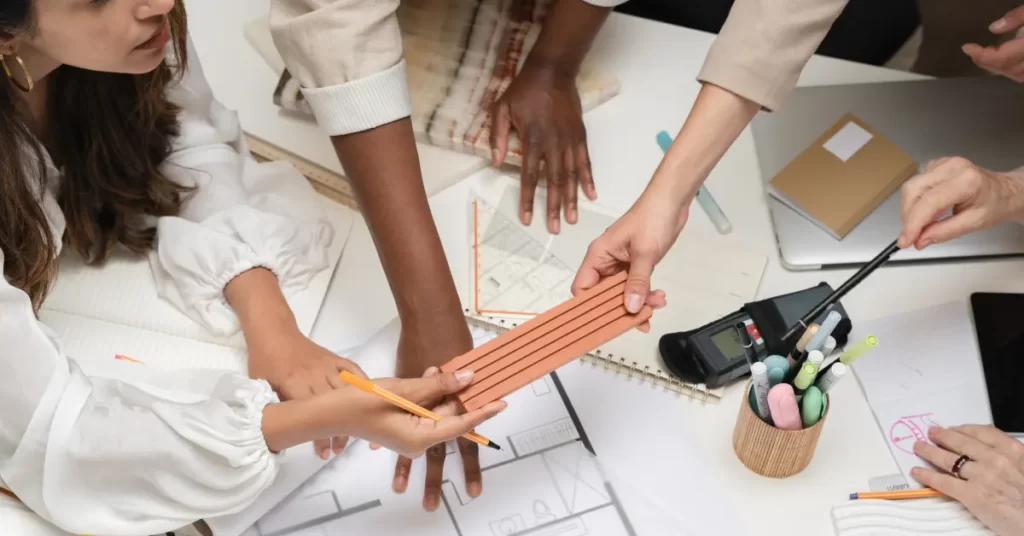
In the dynamic Collaboration Tools in Design Project Management, where creativity meets precision and innovation intertwines with execution, the role of collaboration tools has emerged as a game-changer. As teams become increasingly distributed and projects more complex, the need for seamless communication, efficient resource allocation, and streamlined workflows has never been more pronounced. In this context, collaboration tools have risen to the forefront, revolutionizing how design projects are conceptualized, developed, and brought to fruition.
Collaboration Tools in Design Project Management: Efficiency, Innovation, and Connectivity Unleashed:
- Enhancing Communication and Connectivity
Effective communication is the cornerstone of any successful design project. Collaboration tools act as bridges that connect team members across different geographical locations and time zones. Through real-time messaging platforms, such as Slack and Microsoft Teams, teams can instantly exchange ideas, share updates, and resolve queries, thereby erasing the barriers of distance and facilitating a fluid exchange of information.
Video conferencing tools like Zoom and Google Meet transcend mere text-based communication, enabling face-to-face interactions that nurture a sense of camaraderie among team members. - Streamlining Workflows and Version Control
Design projects involve numerous iterations and versions, which can lead to confusion if not managed meticulously. Collaboration tools like Asana, Trello, and Monday.com offer visual project management interfaces that allow teams to map out tasks, set priorities, and track progress.
These platforms enhance transparency by clearly outlining project timelines and ownership, ensuring that every team member understands their role in the bigger picture. Version control tools, such as GitHub for design files, prevent the chaos of overwritten changes and enable seamless collaboration on shared assets. - Facilitating Real-Time Co-Creation
Modern design is rarely a solitary endeavor; it’s a symphony of ideas coming together. Collaboration tools empower multiple designers to co-create in real time, transcending physical boundaries. Cloud-based design software like Figma and Adobe XD lets designers collaboratively work on the same design files, offering instant feedback and eliminating the need for back-and-forth file exchanges. This real-time co-creation not only accelerates the design process but also results in more holistic and innovative outcomes. - Efficient Resource Allocation and Task Management
Design projects require careful allocation of resources, from human talent to time and budget. Collaboration tools assist in resource allocation by providing clear insights into team availability and project timelines.
Through intuitive dashboards and Gantt charts, managers can distribute tasks effectively, avoiding overburdening individuals or causing bottlenecks. Tools like Harvest and Clockify aid in time tracking, ensuring that billable hours are accurately recorded and resources are allocated judiciously.
- Promoting Cross-Functional Collaboration
Design projects often involve cross-functional collaboration, where designers, developers, marketers, and other stakeholders need to work in harmony. Collaboration tools foster a shared workspace where these diverse teams can collaborate seamlessly.
Document sharing platforms like Google Workspace and Microsoft 365 enable real-time editing and comments, ensuring that all stakeholders are on the same page. This synergy prevents misunderstandings, reduces delays, and ultimately contributes to a more cohesive final product. - Data-Driven Decision Making
In the realm of design project management, data holds the key to informed decision-making. Collaboration tools equipped with analytics and reporting features provide valuable insights into team performance, project progress, and resource utilization. These metrics empower project managers to make data-driven choices, identifying areas that require improvement and capitalizing on successful strategies. - Mitigating Risk through Documentation
Effective documentation is the unsung hero of successful design project management. Collaboration tools maintain a record of discussions, decisions, and changes, acting as a repository of institutional knowledge. This documentation not only aids in resolving disputes and clarifying misunderstandings but also serves as a valuable resource for future projects, enabling teams to learn from past experiences and evolve continuously.
Conclusion
In conclusion, in the intricate dance of design project management, collaboration tools have emerged as catalysts of efficiency, innovation, and connectivity. From bridging geographical gaps to fostering real-time co-creation, these tools empower teams to collaborate seamlessly, streamline workflows, and create exceptional outcomes. As the digital landscape evolves, the role of collaboration tools will continue to expand, shaping the future of design project management into a realm of limitless possibilities.












